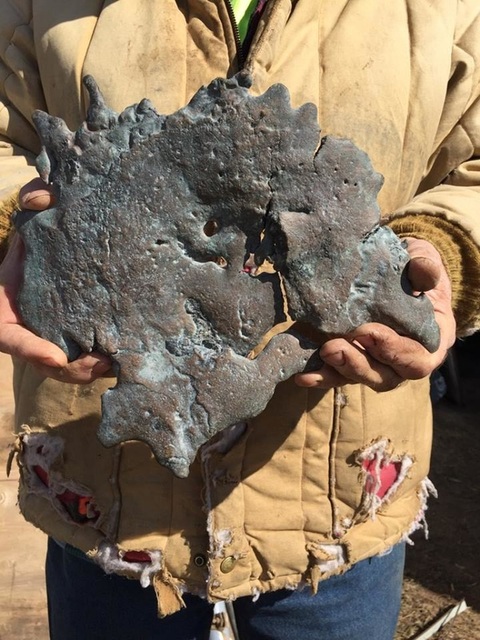 Copper arrowhead embedded in 500-million-year-old sandstone: may or may not have been used to kill a dinosaur.
Copper arrowhead embedded in 500-million-year-old sandstone: may or may not have been used to kill a dinosaur. A recent attempt to breath life into the "debate" about Old World peoples mining copper in the New World comes from J. Hutton Pulitzer, a treasure hunter and one of the self-described "foremost Inventors in modern times." Pulitzer began this quest by getting himself kicked off one of the larger online communities of people interested in ancient copper use in the Great Lakes. When I interacted with Hutton on that site, he accused me of being "out of date" on all of the new information that was available, and indicated that I should listen to his audio interviews in order to educate myself.
Fair enough.
So far, I have only listened to one interview. In the description of this episode (titled "Copper Culture- Where are the Skeletons, Camps, Boats and Signs of Civilizations?"), we are assured that all of the hard evidence that skeptics say is absent has, in fact, already been found. The two people who are going to tell us about these fantastic discoveries, Dave Towle and Scott Mitchen, are presented as experts because they've spent a combined 89 years looking for sites. We are told that they are credible because they, unlike some "white-haired, pony-tailed professor who believes he knows everything," had put "boot to dirt" and gone out to investigate firsthand.
Over the course of the hour, the guests make many assertions about artifacts and other things that they have found. Some of these -- melted copper, a furnace/casting site, etc. -- sound interesting, but as far as I know there are no photos posted online so that we can see them for ourselves (this includes the allegedly melted/cast "starfish" piece Hutton specifically says he's going to post a photo of - maybe it's around but I haven't been able to find it yet [see addendum below]). So most of the interview is just a string of assertions and speculation, not connected to anything that the audience can use to judge the evidence. Is it that difficult to post a photo or two?
In the absence of photos or any other tangible way to evaluate the guests' interpretations of the incredible things they claim to have found, I suggest you listen especially carefully to the portion of the interview from about 43:20 to 48:30. In this segment, you will hear the guests state that they have found copper tools inside blocks of sandstone that are 500 million years old. You will hear a thoughtful discussion of several explanations for this, ranging from (and I'm paraphrasing here) "were they shot into the sandstone when it was soft?" to "polar shifts" to "Man was around then." A little later (about 50:00) we get a mention of "megalithic dinosaur bones" that one of the guests has found on the bottom of Lake Superior.
Now, I think this 500-million-year-old Super Ancient Copper Culture is a game changer for this new exploration of copper mining in ancient North America. At least it's much more interesting than tired tales of Minoans and Phoenicians. In his intro to this interview, Hutton warns us that, unlike stodgy academics, he's going to "address as many sides as possible to talk about the Copper Culture," including the dramatic idea that New World copper mining actually started twelve thousand years ago or more. That's great, because the hypothesis of 500-million-year-old super ancient copper miners hunting dinosaurs to extinction (I'm adding that last part myself - why not teach the controversy?) clearly fits the bill for the "or more" category.
At the end of the interview, Hutton assures us once again that "these are real finds by real people." These, in fact, are the experts since no academic would ever touch such controversy. Given how "volatile" this idea of a 500-million-year-old Super Ancient Copper Culture is, I will expect future interviews in this series to, as promised, fully explore the idea. Hutton, I think you've found your true calling. Great job on the interviewing. Maybe post some photos next time?

In addition to posting this photo, Hutton also posted a screenshot showing that the interview I discuss in this blog post has been played nearly 76,000 times. It is amazing to me (and somewhat disheartening) that apparently I was the first person out of tens of thousands of listeners who actually asked to see the "artifact" they said that we should see. That's kind of a bummer.


 RSS Feed
RSS Feed
